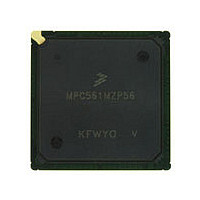MPC561MZP56 Freescale, MPC561MZP56 Datasheet - Page 934

MPC561MZP56
Manufacturer Part Number
MPC561MZP56
Description
Manufacturer
Freescale
Datasheet
1.MPC561MZP56.pdf
(1420 pages)
Specifications of MPC561MZP56
Cpu Family
MPC56x
Device Core
PowerPC
Device Core Size
32b
Frequency (max)
56MHz
Interface Type
QSPI/SCI/SPI/UART
Total Internal Ram Size
32KB
# I/os (max)
56
Number Of Timers - General Purpose
22
Operating Supply Voltage (typ)
2.6/5V
Operating Supply Voltage (max)
2.7/5.25V
Operating Supply Voltage (min)
2.5/4.75V
On-chip Adc
2(32-chx10-bit)
Instruction Set Architecture
RISC
Operating Temp Range
-40C to 125C
Operating Temperature Classification
Automotive
Mounting
Surface Mount
Pin Count
388
Package Type
BGA
Program Memory Type
ROMLess
Program Memory Size
Not Required
Lead Free Status / RoHS Status
Not Compliant
Available stocks
Company
Part Number
Manufacturer
Quantity
Price
Company:
Part Number:
MPC561MZP56
Manufacturer:
Freescale Semiconductor
Quantity:
10 000
Company:
Part Number:
MPC561MZP56R2
Manufacturer:
Freescale Semiconductor
Quantity:
10 000
- Current page: 934 of 1420
- Download datasheet (11Mb)
Development Support
economical interface (three pins) that allows the development system to operate in a lower frequency than
the frequency of the CPU. Note that it is also possible to debug the CPU using monitor debugger software,
for more information refer to
Section 23.5, “Software Monitor Debugger
Support.”
Debug mode is a state where the CPU fetches all instructions from the development port. In addition, when
in debug mode, data can be read from the development port and written to the development port. This
allows memory and registers to be read and modified by a development tool (emulator) connected to the
development port.
For protection purposes, two possible working modes are defined: debug mode enable and debug mode
disable. These working modes are selected only during reset. For more information refer to
Section 23.3.1.1, “Debug Mode Enable vs. Debug Mode
Disable.”
The user can work in debug mode starting from reset or the CPU can be programmed to enter debug mode
as a result of a predefined list of events. These events include all possible interrupts and exceptions in the
CPU system, including the internal breakpoints, together with two levels of development port requests
(masked and non-masked) and one peripheral breakpoint request that can be generated by any one of the
peripherals of the system (including internal and external modules). Each event can be programmed either
to be treated as a regular interrupt that causes the machine to branch to its interrupt vector, or to be treated
as a special interrupt that causes debug mode entry.
When in debug mode an rfi instruction will return the machine to its regular work mode. The debugger
tool should issue an isync instruction to the debug port prior to any other instructions when the CPU enters
debug mode after running code.
The relationship between the debug mode logic to the rest of the CPU chip is shown in
Figure
23-5.
MPC561/MPC563 Reference Manual, Rev. 1.2
23-20
Freescale Semiconductor
Related parts for MPC561MZP56
Image
Part Number
Description
Manufacturer
Datasheet
Request
R

Part Number:
Description:
MPC5 1K0 5%
Manufacturer:
TE Connectivity
Datasheet:

Part Number:
Description:
MPC5 500R 5%
Manufacturer:
TE Connectivity
Datasheet:

Part Number:
Description:
MPC5 5K0 5%
Manufacturer:
Tyco Electronics
Datasheet:

Part Number:
Description:
MPC5 5R0 5%
Manufacturer:
Tyco Electronics
Datasheet:

Part Number:
Description:
MPC5 50K 5%
Manufacturer:
Tyco Electronics
Datasheet:

Part Number:
Description:
MPC5 1R0 5%
Manufacturer:
Tyco Electronics
Datasheet:

Part Number:
Description:
TOWER ELEVATOR BOARDS HARDWARE
Manufacturer:
Freescale Semiconductor
Datasheet:

Part Number:
Description:
TOWER SERIAL I/O HARDWARE
Manufacturer:
Freescale Semiconductor
Datasheet:

Part Number:
Description:
LCD MODULE FOR TWR SYSTEM
Manufacturer:
Freescale Semiconductor
Datasheet:

Part Number:
Description:
DAUGHTER LCD WVGA I.MX51
Manufacturer:
Freescale Semiconductor
Datasheet:

Part Number:
Description:
TOWER SYSTEM BOARD MPC5125
Manufacturer:
Freescale Semiconductor
Datasheet:












